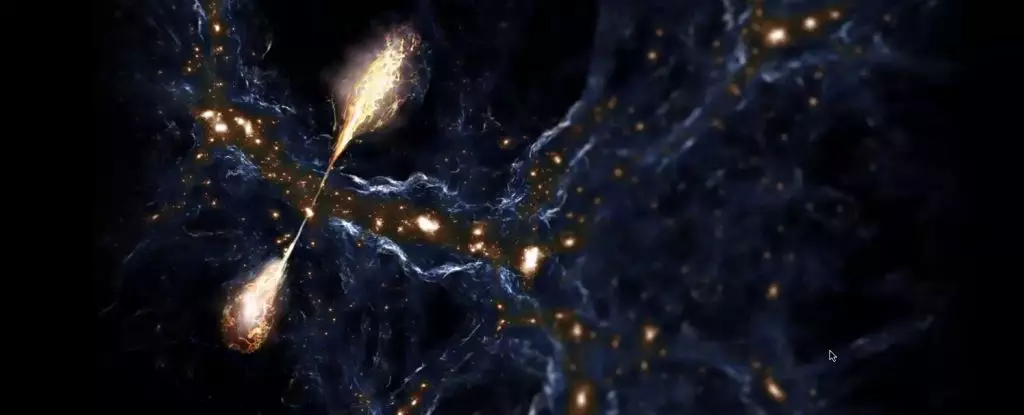The discovery of the supermassive black hole named Porphyrion has fundamentally altered our understanding of large-scale cosmic structures. Spanning approximately 7 megaparsecs, or about 23 million light-years, Porphyrion is not just an astronomical oddity; it’s a connection point to some of the universe’s most profound mysteries. Dubbed after the king of giants in Greek mythology, this massive structure underscores the intimate relationship between cosmic entities, opening the door for discussions on galactic interconnections, jet formations, and celestial evolution.
A Record-Breaking Discovery
With its astonishing size and power, Porphyrion significantly contributes to our comprehension of the cosmic web that interlinks galaxies and clusters in the universe. Astronomer Martijn Oei from Leiden University and Caltech sheds light on the scale of this black hole’s jets, likening them to “the energetic output of an amoeba producing a fountain as immense as the Earth.” This vivid comparison emphasizes the jaw-dropping proportions involved, showcasing the extraordinary capabilities of such a seemingly diminutive object on the cosmic stage.
This finding becomes even more intriguing in the context of existing structures like Alcyoneus, a galaxy already known for its staggering jets spanning 16 million light-years. Together, these discoveries suggest that the factors necessary for producing such colossal jets may be more commonplace in our universe than previously understood, challenging long-held assumptions about black hole behaviors and their implications on cosmic architecture.
Astrophysical jets from black holes occur under quite complex mechanisms that science is still working to fully decipher. Typically, highly energetic jets form when black holes consume surrounding matter, funneling it through magnetic field lines toward their poles. This acceleration propels plasma at astonishing velocities close to the speed of light, resulting in the formation of the jets we observe.
However, the extended lengths of jets from both Porphyrion and Alcyoneus present unique challenges. Continuous feeding is essential for generating such immense jets, implying a vast reservoir of material must persist for a billion years or more—an extraordinary requirement that is not frequently met. Additionally, longer jets tend towards instability, raising questions about how these impressive structures maintained their integrity over vast distances. Theoretical models suggest that once disrupted, these jets are predisposed to fall apart, complicating our understanding of their longevity.
The longevity and stability of Porphyrion’s jets challenge our existing framework concerning cosmic jet formation. Current astrophysical models imply that instabilities could obliterate these monumental jets, but observational evidence indicates that they have persisted across both time and space. This observation compels scientists to re-examine existing theories and hints at a deeper interaction between black holes and their environments than previously recognized.
These jets could potentially alter the nature of the cosmic web, influencing the temperatures and magnetic field structures within voids between galaxies. Such interactions suggest that jets are not mere byproducts of black hole activity; they may actively sculpt the universe’s large-scale structure. Remarkably, given that Porphyrion is an example of a type of black hole frequently observed in the early universe, researchers are left to ponder the implications of abundant jet-generating black holes in cosmic history.
The Future of Cosmic Observations
As we continue to push the boundaries of what we know through advancements in observational technology, the prospect of finding more galaxies with massive jets looms large. Oei speculates that the universe may be teeming with these enigmatic structures, though their visibility diminishes as they grow and recede into the cosmic backdrop. This hints at an evolving understanding of our universe, where once-misunderstood phenomena could reshape our ideas about galactic formation and interaction.
In the coming years, enhanced observational capabilities may uncover myriad examples of large-scale jets across distant galaxies, fostering a richer appreciation of the cosmic web’s intricate tapestry. Each new discovery can fundamentally shift our comprehension of cosmic evolution, providing additional insights into the forces that shape our universe.
The unearthing of Porphyrion marks not only a significant scientific achievement but serves as a reminder of how much remains to be learned about the universe’s complexities. As astronomers and physicists untangle the threads linking these gargantuan formations, we inch closer to answering fundamental questions about the nature of reality. Thus, as we gaze into the cosmos, it becomes clear that every answer leads to new questions, prompting infinite exploration within this vast and beautiful universe.


Leave a Reply